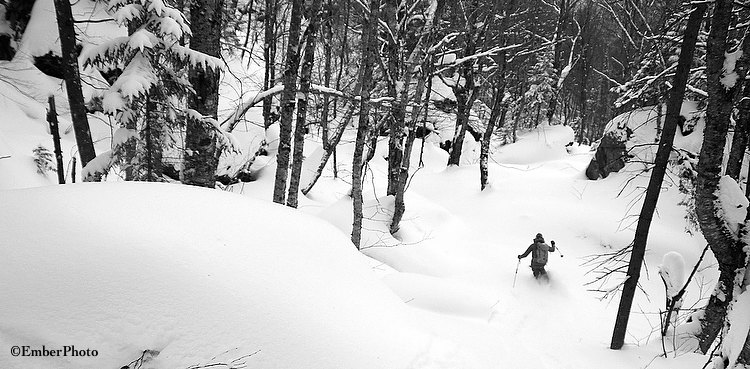Finding its voice: Vermont’s backcountry movement galvanizes support with CTA, RASTA, others
Moretown, VT — Last November, backcountry skiers gathered at the Pierce Hall Community Center in Rochester to discuss issues and concerns related to back- country access. What started as a town meeting for a local group, the Rochester Area Sports Trail Alliance (RASTA), galvanized statewide enthusiasm for back- country skiing and riding.
For Moretown-based photographer Brian Mohr, the dialogue was inspirational.
An accomplished photographer with work featured in national magazines like Outside, Skiing and the New York Times, Mohr is also an avid backcountry skier and produces much of his work with his wife, Emily Johnson, in the Green Mountains. This winter, Mohr was part of a group of about 20 who helped start the Vermont Backcountry Alliance, a group that aspires to be the voice of the backcountry skiing and riding community.
Mohr says the Alliance is part of a natural progression of the backcountry community.
“Skiing is finally coming full circle with its roots in Vermont,” he says. “It’s exciting to see the sport evolve … it is the result of several decades of activity and discussion around backcountry skiing and riding.”
Mohr points to the Catamount Trail Association (CTA), the Rochester Area Sports Trail Alliance (RASTA) and the Friends of Bolton Valley Nordic and Backcountry as examples of different groups operating on different levels to boost the same community. The CTA maintains some 300 miles of trail throughout the state; RASTA is in the midst of planning the establishment of a “backcountry zone” on state land, and the Bolton group succeeded in conserving 1,161 acres in June 2013, now protected as part of the Mansfield State Forest.
Parallel to the work done by these regional groups, state and federal land agencies (the forest service) have recently been eager to work with the backcountry community and, at the forum in November, encouraged members to present a unified front.
“They’ve come to the community, both at the forum and through other discussions, seeking input from us,” he says. “They’re seeking our help in developing land management strategies that accommodate backcountry skiing and riding. Just as they have land management strategies for hiking, hunting, fishing and logging, finally backcountry skiing and riding are becoming another use of our national forests and state lands.”
Mohr says those strategies will vary by tract of land, but the purpose will be to ensure that everyone’s voice is heard.
This winter, with the help of the Catamount Trail Association, the group of 20 volunteers met on several occasions to decide on a name and to write a proposed mission for the group. The working group includes Amy Kelsey, president of the Catamount Trail Association and Jason Duquette-Hoffman, president of Worth Skis, on the Organizational Team; John Egan of Sugarbush Resort, is the ski resort liaison; and Matt Bruhns, compliance manager of Burton Snowboards is liaison to the snowboard community.
Mohr says the group calls him the unofficial “Ski- E-O.”
The Alliance emphasizes conservation, outreach, education and terrain management in their mission, but Mohr says for now the main objective is to engage with the community and define the group’s mission. To that end, the VTBC began hosting a survey in March that asks participants questions ranging from what kind of terrain they prefer, to what kind of organization would best represent the interests of skiers and riders.
“It’s important for us to know who we are as a community before we jump into any projects or push any specific agenda,” he says.
After the survey finishes in May, Mohr says the results will be one of many factors the group considers when deciding what projects to take on. The VTBC will also hold an additional survey this summer and another community forum in the fall to decide on a course of action. Some early suggestions for projects include build- ing a system of backcountry cabins for overnight snow travelers, crafting a Vermont backcountry skiing and riding code of ethics, and even developing a designated backcountry skiing and riding zone.
Mohr says he and others in the group of 20 are encouraged by the results.
“There’s a lot on the table and it’s exciting to think where the sport could go, moving forward.”

